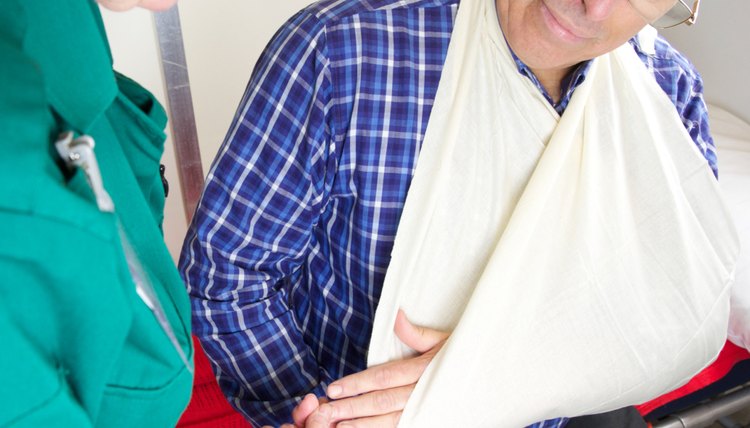Types of Arm Slings

An arm sling is a bandage that is used to give support to an injured joint. Typically slings are used when a joint is damaged, dislocated or injured due to surgery. The sling keeps the injured arm or shoulder immobile so that muscles, bones and tendons have time to heal. Three basic types of slings are used for arm and shoulder injuries.
About Slings
The most effective slings are generally made from a piece of triangular cotton bandage. You’ll find these bandages in most first aid kits. In an emergency, slings can be made from materials such as a belt or a piece of clothing. In first aid situations where the extent or type of injury is unknown, slings can be used to temporarily immobilize the arm to prevent worsening the injury and to offer some relief from discomfort. When applying a sling it is important to ensure there is proper circulation in the supported arm. Checking the pulse at the wrist or squeezing a fingernail to look for color change in the nail bed will let you know if the sling should be altered.
Standard Arm Sling
The standard arm sling is intended for injuries to the forearm such as fractures or sprains. It supports the forearm so that it rests roughly parallel to the ground, with the wrist higher than the elbow. It is slung over the shoulder on the uninjured side of the body and tied to secure it in place.
Elevated or Shoulder Sling
Slings are also used to aid in supporting the shoulder when injured. Like other types of slings, a shoulder or elevated sling is made from a triangular piece of cloth. The arm is placed over it so that the top point of the triangle is at the elbow and the wrist rests between the other two points, which are then brought up and tied behind the neck. There are variations to the shoulder sling, depending on the amount of immobility required, but all are designed to limit shoulder movement while the injury heals.
Collar-and-Cuff Sling
The collar-and-cuff sling is used in upper arm injuries or in the case of a suspected dislocated collar bone or when a standard bandage is not available. The elbow hangs naturally at the side of the body and the hand of the injured arm is extended to the uninjured shoulder. A strip of cloth or a belt is wrapped around the wrist of the injured arm and the ends are wrapped around the neck and tie. The arm hangs comfortably with a collar-and-cuff sling, and is not completely immobile. If extra support is needed, bandages or wraps can be applied around the body and upper arm to hold the arm firmly at the chest.
References
Writer Bio
Renee Miller began writing professionally in 2008, contributing to websites and the "Community Press" newspaper. She is co-founder of On Fiction Writing, a website for writers. Miller holds a diploma in social services from Clarke College in Belleville, Ontario.
